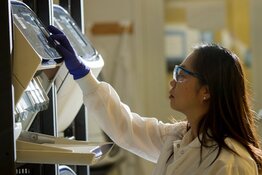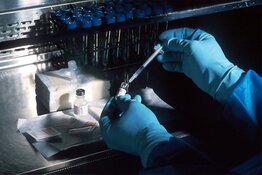The Life Sciences Report: Patrick, you will be speaking at the Altegris Advisors LLC/Mauldin Economics conference in San Diego later in May on the topic of investing in a transformational world. What do you mean by "transformational"?
Patrick Cox: Transformational technologies change existing paradigms by causing massive disruption—destroying old industries while creating new ones. That is what we are now experiencing: The old ways are obsolescing as new solutions emerge.
TLSR: How is this playing out in the life sciences realm?
PC: Innovations and discoveries in the life sciences are bigger than in other fields. Especially with DNA, which is an ancient system of incredible complexity and sophistication. DNA-based breakthroughs in medical research are personally valuable to most people. The new DNA-based industry aims at curing diseases and extending the healthy portion of our lives significantly.
TLSR: What transformational companies do you like in the biotech world?
PC: I am not going to give away the companies I will be talking about at the San Diego conference. But I've spoken with The Life Sciences Report previously about Inovio Pharmaceuticals Inc. (INO:NASDAQ). The company continues to thrive.
Inovio's approach to cancer is immunotherapeutic. Instead of poisoning the body and hoping that the cancer dies first, Inovio is developing therapies that allow the body to more effectively prevent and fight cancers. This completely disrupts the status quo; it is changing the way we model cancer, especially in terms of new diagnostics like those coming out of companies like BioTime Inc. (BTX:NYSE).
TLSR: Is Inovio engaged in trials that could be game-changers?
PC: Inovio continues to validate the approach developed by David Weiner, acknowledged as the father of DNA vaccines, and Joseph Kim, the CEO of Inovio. The value of the company's platform is evidenced by the participation of Roche Holding AG (RHHBY:OTCQX). That means that Roche's lawyers have vetted Inovio's intellectual property (IP).
"Inovio Pharmaceuticals Inc. continues to thrive; it controls a massive amount of intellectual property."
A lot of people are working on DNA vaccines. Most of them have nothing that even comes close to replicating Inovio's powerful combination of electroporation (using electrical pulses to gain entry to the cell) and sophisticated plasma constructs. And in the long run, a lot depends upon who can control the patents. Inovio is the product of the merger of the half-dozen most important pioneers in DNA vaccines, including Weiner and Kim. The company controls a massive amount of IP.
TLSR: What kinds of products are emerging out of Inovio's wealth of IP?
PC: Inovio's agricultural subsidiary, VGX Animal Health Inc., working in Australia, is developing vaccines for different mammals. Inovio's vaccine platform aims to increase the productivity and the health of organisms, as opposed to just preventing disease.
Oddly, the life sciences business has a phobia about accepting anything that is not documented by human trials. That is nonsense. If there are important DNA vaccine therapies going on with pigs, cows and horses without adverse events, then the therapy is going to work with people, too.
TLSR: One of the criticisms of the dairy industry has been the use of growth hormones and vaccines. Does Inovio's line go some distance toward alleviating that fear because it uses the body's own DNA, as opposed to inserting a sample of a disease to vaccinate?
PC: How people who hold irrational beliefs are going to react to another technological advance is always a puzzle.
TLSR: Even irrational beliefs can have market consequences.
PC: Correct, but how do you predict what irrationality will do? In the long run, productivity and profits will triumph.
TLSR: Are DNA-based vaccines predicted to be cheaper than the status quo?
PC: The status quo does not approach the same clinical targets. However, DNA vaccines are not terribly expensive. The plasmids on a large scale are inexpensive, and electroporation is not a costly technology. There is one machine and a disposable unit, so the production cost is not significant. These are pharmaceutical products, so the production cost does not really matter, as the prices are market-based.
TLSR: I notice that Inovio has a preclinical study for a vaccine that protects against the Ebola and Marburg viruses. Are these diseases spreading out of Africa?
PC: Ebola is threatening the world. It is just a question of time before it will show up in New York City, Hong Kong and London.
TLSR: Through bioterrorism or hitchhiking?
PC: Probably hitchhiking, though bioterrorism is always a concern. That is why the Defense Advanced Research Projects Agency is very concerned about Ebola as a weapon of bioterrorism. But birds and pigs are terrorists, too, in that sense. Ebola epidemics are inevitable.
TLSR: What about influenza? What has Inovio done on that front?
PC: In the long run there will be an influenza vaccine, and Inovio will probably have it. There are other approaches to curing the disease, however. At the San Diego conference, I will cover some disruptive, transformational technologies for dealing with influenza that have nothing to do with DNA vaccines.
TLSR: You recently wrote about Bill Gates' malaria initiative as accelerating the Inovio vaccine development program. Can you speak a little bit about that?
PC: Gates and the PATH Malaria Vaccine Initiative do not hand out grant money dumbly or casually. The foundation's choice of Inovio as a developer of an antimalarial vaccine is important. Inovio will almost certainly succeed in developing a vaccine for malaria. PATH will own the rights to use this treatment for humanitarian reasons where malaria is endemic, so Inovio will own a traveler vaccination that may be free inside Africa. But tourists and travelers will have to pay for the vaccination before visiting Africa.
TLSR: Inovio seems to have a number of irons in the fire. What else attracts you to the firm?
PC: I am very interested in the potential market for Inovio's human growth-hormone-releasing hormone (GHRH). Aging movie stars go to high-end clinics for injections of growth hormone. It is widely used in bodybuilding and weightlifting sports. And it works. People who use growth hormone see their skin become younger, their muscle strength increase. There is an approved growth hormone product for AIDS victims. And it helps with body fat.
TLSR: How so?
PC: The reason that older people have large guts is because their growth hormone levels fall as they age, and, as a result, people end up with stubborn intra-abdominal fat, belly fat. But inject growth hormone and the rubber tire deflates! The problem with using growth hormone, however, is that it has side effects. I would not take it. I can understand why an actor who makes millions of dollars a movie may want to look younger, or why an athlete whose multimillion-dollar career depends on performance would use these expensive products. But for the average person, the cost and risk of injecting growth hormones is probably too great, mostly because an exogenous increase in growth hormone levels fundamentally upsets the regulatory axis in the body.
"The old ways are obsolescing as new solutions emerge."
On the other hand, we know from testing animals inoculated with DNA-based growth hormones that an inoculated body begins to produce growth hormones all by itself. In which case, there are no side effects. Aging baby boomers are going to demand access to a growth hormone vaccine like this when it becomes known. This is part of the long-term potential of DNA vaccines. It's much greater than cancer. At the moment, Inovio is not actively developing this therapy for humans (it is approved in Australia for use in swine). But it represents the depth of the company's platform.
TLSR: When a company makes a transformational breakthrough, such as in DNA vaccines, does this strengthen our economy?
PC: The macroeconomic drivers in life sciences are tied to the radical increase in life span that has taken place very recently. Since the American Revolution, life spans have more than doubled. In my lifetime, the average life span has increased by more than 30 years. We still have a social service model instituted when birth rates were high and life spans were relatively short. In 1950, just before I was born, I think there were about 16 workers for every retired person. Today, it's fewer than three working persons per retired person. Moreover, healthcare costs go up as we get older. Alzheimer's disease and heart disease are incredibly expensive to treat and live with. When people lived to 65 on average, those diseases were not particularly evident.
TLSR: Does Inovio have anything in the pipeline that looks at Alzheimer's?
PC: This is an innovative company, and it is looking at all kinds of things. There is nothing in current development, but I've discussed the possibility with the company. It's a longer-term potential application. Several other companies are on track for dramatically delaying, but not curing, Alzheimer's.
TLSR: What about regenerative medicine?
PC: Regenerative medicine is the most transformational of all the medical therapies, because it has the potential to reverse cellular aging. BioTime is working with stem cells that it can program to become cardiomyocytes, heart muscle cells. BioTime's researchers have seen the cells self-assemble in a dish and begin to beat like a heart! And we know from animal experiments that rejuvenated cardiomyocytes can integrate into the heart and heal damaged heart muscles. Stem cells are looking good.
TLSR: Does BioTime have a product based on this stem cell research?
PC: It has a subsidiary, ReCyte Therapeutics Inc., which is developing a delivery system for rejuvenated cardiomyocytes—sort of an epoxy that can be molded. It can make joints or flesh in reconstructive surgery. It creates a permanent matrix in which stem cells prosper, including in the heart. Third-party testing has validated this approach. But ReCyte Therapeutics' first product is slated to be endothelial precursors.
TSLR: What are endothelial precursors?
PC: Among gerontologists, there is a saying, "You're as old as your endothelium." The endothelium is a thin layer of cells inside the entire circulatory system—heart, arteries, capillaries. When you are young, it provides nitric oxide, which is an important neurotransmitter because it passes through cell walls. It is very short-lived, but it is responsible for vessel dilation. If you need additional blood flow for exercise or injury repair, or for any reason, the endothelium activates nitric oxide, which causes dilation and increases blood flow. When that does not work, there are all kinds of consequences—erectile dysfunction, hypertension, macular degeneration. It is a big killer, which is why the endothelium is the most important target for regenerative medicine.
TLSR: How can this process be industrialized?
PC: The endothelium does not regenerate by cell replication inside the cell walls. It exists as precursor cells inside the marrow of the larger bones, where the immune system resides. These cells simply circulate, find where they are needed, and engraft. If you were injected with your own endothelial precursor cells, they would migrate to the marrow of your large bones. We now know, from doing research on blood cancers, that the immune system can be rebooted without ablating bone marrow to generate replacement of old, sick endothelial precursors with new ones.
"How do you predict what irrationality will do? In the long run, productivity and profits will triumph."
Michael West, who founded Geron Corp. (GERN:NASDAQ) and now owns Geron's IP, did this with cows. And Geron and BioTime have merged on the stem cell/regenerative medicine front. Dr. West ablated the bone marrow of one group of cows and then injected epithelial precursors. But as a control, he also injected the precursors into cows without ablative bone marrow. In both groups, the younger, healthier endothelial precursors replaced the older, unhealthier ones.
Blood cancer researchers have found the same thing. This is really a remarkably simple process. It is now possible to take cells from the patient, convert them to induced pluripotent stem cells [able to become any kind of cell], engineer them to become endothelial precursors, and then simply inject them into the patient. The precursors migrate to the bone marrow and replace the older, nonfunctioning or less functional endothelium with what is essentially a child's endothelium in terms of health and functionality.
TLSR: That sounds transformational in more ways than one.
PC: I'll say.
TLSR: Let's talk about the financial fundamentals of both of these companies—BioTime and Inovio. Who are their competitors? How do they stack up against them?
PC: Frankly, Inovio does not really have competitors. It is up against companies with virus delivery DNA, for example—a technique for engineering a virus to infect a cell. The technique is not very efficient compared to Inovio's DNA-based vaccine techniques, and it has potential problems. There are companies using electroporation, which is the process of opening the pores and cell membranes to insert treatments into the cells. It is not clear to me, however, that these firms can legally do this because of Inovio's IP. Remember, David Weiner is one of the two largest investors in Inovio, and he is the father of DNA vaccine, so the company is positioned head-and-shoulders above any others.
"The macroeconomic drivers in life sciences are tied to the radical increase in life span that has taken place very recently."
BioTime is in the same IP situation, given the Geron merger. And its CEO, Michael West, has also acquired important IP from other companies. Nobody else is in any kind of a position to compete with BioTime in terms of regenerative medicine with pluripotent stem cells. There are lots of companies out there, but they are using adult stem cells for the most part. The potential of those cells is very limited compared to pluripotent stem cells.
TLSR: Are these companies accumulating debt?
PC: Both Inovio and BioTime are focusing, in the short term, on getting products to market. Both are engaged in clinical trials. It has been a long and expensive process to get there, but that is what it takes. Both firms are in the process of transitioning to companies with therapies on the market that produce income.
TLSR: How will the costs of healthcare decrease in your transformational model?
PC: Think about the cost of a heart attack and the subsequent care—hundreds of thousands of dollars over a lifetime right now. I predict that the cost of endothelial precursor therapy will eventually get that cost down to $10,000. Given the hundreds of thousands of dollars we spend on an Alzheimer's patient today, it's very unlikely that any of the drugs or the cells that are used to cure Alzheimer's will cost even a significant fraction of today's price tag.
TLSR: There will be less need for palliative care and radical surgery?
PC: That is right. Also, working careers will lengthen appreciably. People in the investment business know the impact of exponential growth on a portfolio. Despite the fact that everybody is worked up about income inequality, the real cause of income inequality is the fact that we have a much older and larger population. Older folks have worked long and grown their portfolios. As we extend life spans and careers, income inequality will increase spectacularly, as older people continue to get richer.
TLSR: What kind of life span do you look at for the average human of the future?
PC: A life span of centuries. Right now, our lives are bounded by our Hayflick limit—we are born with potential for about 120 cell replications. This is determined by the telomere, which is the nub on the zipper of an individual's DNA. Every time a cell replicates, we use up one of the telomere nubs. When we run out, the cell simply stops reproducing. Modern medicine is mostly trying to stop diseases that kill us before we reach our Hayflick limit. And we will do that. We will cure heart disease, cancer, Alzheimer's, liver disease; we will beat viruses; and we will end the factors that cause accelerated aging—inflammation, fibrosis, mitochondrial dysfunction. This will take us to a life span of about 120 years.
Beyond that, we will turn to regenerative medicine to rejuvenate cells, and there are a number of ways to do this. The first major breakthrough will probably be endothelial precursors rejuvenating endothelium, which will largely eliminate heart disease and stroke.
TLSR: Are we going to end up with 20 billion people who are 300 years old?
PC: That is a myth. If you look at the math, we are in serious depopulation right now. The West is disappearing. Iceland's birth rate is so low that the country has come to grips with the fact that it is disappearing as a culture. Japan is trying to increase its birth rates. Africa and the Middle East still have relatively high birth rates, but they are falling too. As they fall, we will see a diminishing global population. We are using a fraction of the earth's surface to produce food, minerals and energy. I am not at all worried about population.
TLSR: If you were able to live another 200 years, what would you do?
PC: I am interested in particle physics, and music and skateboarding.
TLSR: Thanks for your time today, Patrick.
PC: A pleasure.
Patrick Cox is the editor of Transformational Technology Alert. He has lived in the world of technology breakthroughs for the past 30 years. He has written more than 200 editorials for USA Today and has appeared in The Wall Street Journal and on CNN's "Crossfire" television program. In the late 1980s, he edited and published one of the first industry-insider software magazines, writing about topics like open-source and user-supported software long before those ideas were widely understood. Later, Cox wrote presentations and speeches for the CEO of Netscape. His consulting work has taken him to Fortune 500 boardrooms and inside the war rooms of national political candidates. His independent research is based solely on his investigations in transformational wealth-building companies and close consultation with Nobel Prize-winning economists and scientists.
Read what other experts are saying about:
Want to read more Life Sciences Report interviews like this? Sign up for our free e-newsletter, and you'll learn when new articles have been published. To see recent interviews with industry analysts and commentators, visit our Streetwise Interviews page.
DISCLOSURE:
1) Peter Byrne conducted this interview for Streetwise Reports LLC, publisher of The Gold Report, The Energy Report, The Life Sciences Report and The Mining Report, and provides services to Streetwise Reports as an independent contractor. He owns, or his family owns, shares of the following companies mentioned in this interview: None.
2) The following companies mentioned in the interview are sponsors of Streetwise Reports: Inovio Pharmaceuticals Inc. Streetwise Reports does not accept stock in exchange for its services.
3) Patrick Cox: I own, or my family owns, shares of the following companies mentioned in this interview: None. I personally am, or my family is, paid by the following companies mentioned in this interview: None. My company has a financial relationship with the following companies mentioned in this interview: None. I was not paid by Streetwise Reports for participating in this interview. Comments and opinions expressed are my own comments and opinions. I had the opportunity to review the interview for accuracy as of the date of the interview and am responsible for the content of the interview.
4) Interviews are edited for clarity. Streetwise Reports does not make editorial comments or change experts' statements without their consent.
5) The interview does not constitute investment advice. Each reader is encouraged to consult with his or her individual financial professional and any action a reader takes as a result of information presented here is his or her own responsibility. By opening this page, each reader accepts and agrees to Streetwise Reports' terms of use and full legal disclaimer.
6) From time to time, Streetwise Reports LLC and its directors, officers, employees or members of their families, as well as persons interviewed for articles and interviews on the site, may have a long or short position in securities mentioned. Directors, officers, employees or members of their families are prohibited from making purchases and/or sales of those securities in the open market or otherwise during the up-to-four-week interval from the time of the interview until after it publishes.










































